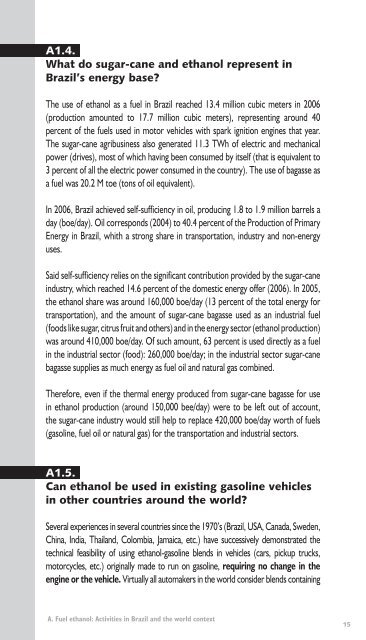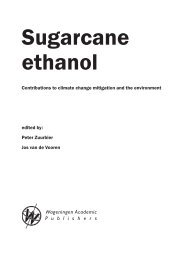Production and use of fuel ethanol in Brazil - BAFF
Production and use of fuel ethanol in Brazil - BAFF
Production and use of fuel ethanol in Brazil - BAFF
Create successful ePaper yourself
Turn your PDF publications into a flip-book with our unique Google optimized e-Paper software.
A1.4.<br />
What do sugar-cane <strong>and</strong> <strong>ethanol</strong> represent <strong>in</strong><br />
<strong>Brazil</strong>’s energy base?<br />
The <strong>use</strong> <strong>of</strong> <strong>ethanol</strong> as a <strong>fuel</strong> <strong>in</strong> <strong>Brazil</strong> reached 13.4 million cubic meters <strong>in</strong> 2006<br />
(production amounted to 17.7 million cubic meters), represent<strong>in</strong>g around 40<br />
percent <strong>of</strong> the <strong>fuel</strong>s <strong>use</strong>d <strong>in</strong> motor vehicles with spark ignition eng<strong>in</strong>es that year.<br />
The sugar-cane agribus<strong>in</strong>ess also generated 11.3 TWh <strong>of</strong> electric <strong>and</strong> mechanical<br />
power (drives), most <strong>of</strong> which hav<strong>in</strong>g been consumed by itself (that is equivalent to<br />
3 percent <strong>of</strong> all the electric power consumed <strong>in</strong> the country). The <strong>use</strong> <strong>of</strong> bagasse as<br />
a <strong>fuel</strong> was 20.2 M toe (tons <strong>of</strong> oil equivalent).<br />
In 2006, <strong>Brazil</strong> achieved self-sufficiency <strong>in</strong> oil, produc<strong>in</strong>g 1.8 to 1.9 million barrels a<br />
day (boe/day). Oil corresponds (2004) to 40.4 percent <strong>of</strong> the <strong>Production</strong> <strong>of</strong> Primary<br />
Energy <strong>in</strong> <strong>Brazil</strong>, whith a strong share <strong>in</strong> transportation, <strong>in</strong>dustry <strong>and</strong> non-energy<br />
<strong>use</strong>s.<br />
Said self-sufficiency relies on the significant contribution provided by the sugar-cane<br />
<strong>in</strong>dustry, which reached 14.6 percent <strong>of</strong> the domestic energy <strong>of</strong>fer (2006). In 2005,<br />
the <strong>ethanol</strong> share was around 160,000 boe/day (13 percent <strong>of</strong> the total energy for<br />
transportation), <strong>and</strong> the amount <strong>of</strong> sugar-cane bagasse <strong>use</strong>d as an <strong>in</strong>dustrial <strong>fuel</strong><br />
(foods like sugar, citrus fruit <strong>and</strong> others) <strong>and</strong> <strong>in</strong> the energy sector (<strong>ethanol</strong> production)<br />
was around 410,000 boe/day. Of such amount, 63 percent is <strong>use</strong>d directly as a <strong>fuel</strong><br />
<strong>in</strong> the <strong>in</strong>dustrial sector (food): 260,000 boe/day; <strong>in</strong> the <strong>in</strong>dustrial sector sugar-cane<br />
bagasse supplies as much energy as <strong>fuel</strong> oil <strong>and</strong> natural gas comb<strong>in</strong>ed.<br />
Therefore, even if the thermal energy produced from sugar-cane bagasse for <strong>use</strong><br />
<strong>in</strong> <strong>ethanol</strong> production (around 150,000 bee/day) were to be left out <strong>of</strong> account,<br />
the sugar-cane <strong>in</strong>dustry would still help to replace 420,000 boe/day worth <strong>of</strong> <strong>fuel</strong>s<br />
(gasol<strong>in</strong>e, <strong>fuel</strong> oil or natural gas) for the transportation <strong>and</strong> <strong>in</strong>dustrial sectors.<br />
A1.5.<br />
Can <strong>ethanol</strong> be <strong>use</strong>d <strong>in</strong> exist<strong>in</strong>g gasol<strong>in</strong>e vehicles<br />
<strong>in</strong> other countries around the world?<br />
Several experiences <strong>in</strong> several countries s<strong>in</strong>ce the 1970’s (<strong>Brazil</strong>, USA, Canada, Sweden,<br />
Ch<strong>in</strong>a, India, Thail<strong>and</strong>, Colombia, Jamaica, etc.) have successively demonstrated the<br />
technical feasibility <strong>of</strong> us<strong>in</strong>g <strong>ethanol</strong>-gasol<strong>in</strong>e blends <strong>in</strong> vehicles (cars, pickup trucks,<br />
motorcycles, etc.) orig<strong>in</strong>ally made to run on gasol<strong>in</strong>e, requir<strong>in</strong>g no change <strong>in</strong> the<br />
eng<strong>in</strong>e or the vehicle. Virtually all automakers <strong>in</strong> the world consider blends conta<strong>in</strong><strong>in</strong>g<br />
A. Fuel <strong>ethanol</strong>: Activities <strong>in</strong> <strong>Brazil</strong> <strong>and</strong> the world context<br />
15












